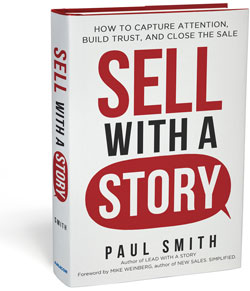All the fancy marketing maneuvers and hard work to promote a product is worth little if you cannot close the deal. It takes effective selling to make a sale. Effective selling is a method that can be learned. It’s the successful finishing touch to a comprehensive marketing strategy.
“Sell with a Story: How to Capture Attention, Build Trust, and Close the Sale” by Paul Smith is a practical guide that explains the human touch of a well-crafted story and how to do it. The book goes beyond scripted sales pitches. Rather, it establishes a compelling reason for the purchase with an emotive touch to close the deal. It goes well beyond the single purchase. The story establishes the base for lasting relationships and many more deals.
The examples in the book are priceless. They range from artwork of pigs swimming for food, fundraising for a university and to upgrading a computer system to reduce costs. Smith takes each story apart into six components to provide a structure and a form of template to create your own effective story. The story must be logical and emotive – it must make sense to the head and touch the heart.
 The six attributes to creating a compelling story are:
The six attributes to creating a compelling story are:
A time indicator to frame the story into a sense of time to show it actually happened. An example may be, “when my car broke down last month…” or, “the last time I was on vacation…“
A place indicator gives the story legitimacy where it happened, such as “when I was rushing to catch a plane in Boston…” or “during an important meeting in our office…”
A main character that may be a person, an animal, a company or even a brand. This gives the story context for the story narrative.
An obstacle needs to be introduced to focus on the problem to be solved. It can be a competitor, a disease or a malfunctioning system.
A goal needs to be the target to fix the problem. The story can infer problem solving and does not need to discuss the specific problem the client has. Instead, it should give a sense of fixing a problem.
An event. The story needs to have action on what happened and how a problem was resolved.
Most importantly, the crafted story should be brief and interesting. It should avoid boring details and should not be private or too personal, which tends to make the listener uncomfortable. The book has many examples of the type of stories that sell well and also create a lasting impression.
The book takes sales to a higher level of planning and delivery. Instead of the “canned” sales pitches that prove to be ineffective, author Paul Smith serves as a coach to outline a successful structure. He also discusses the psychology of the sales exchange that builds trust and a lasting client.
This book would serve well as a team training tool and would be an excellent investment for any business. Sales, after all, are a necessity for survival.
Lucia Worthington teaches business and management at Clark College. To recommend a book for review, email bookreviews@vbjusa.com.

